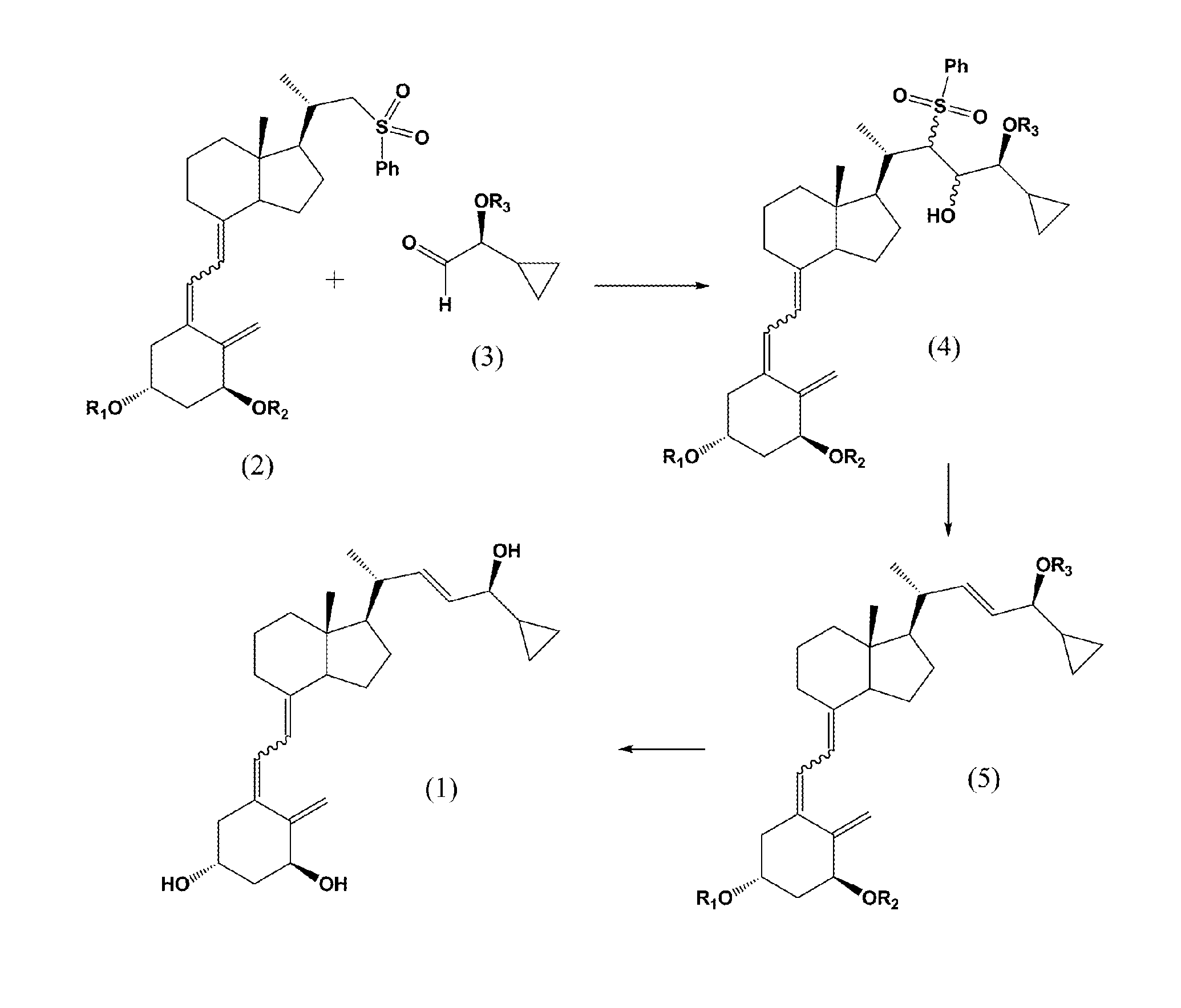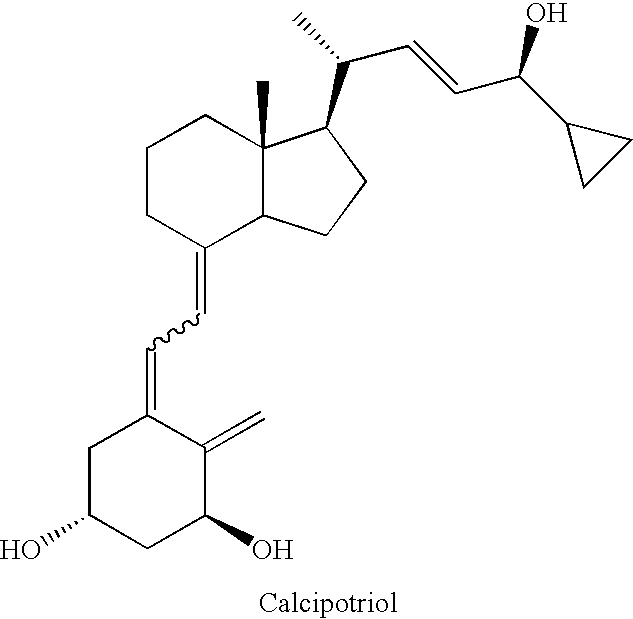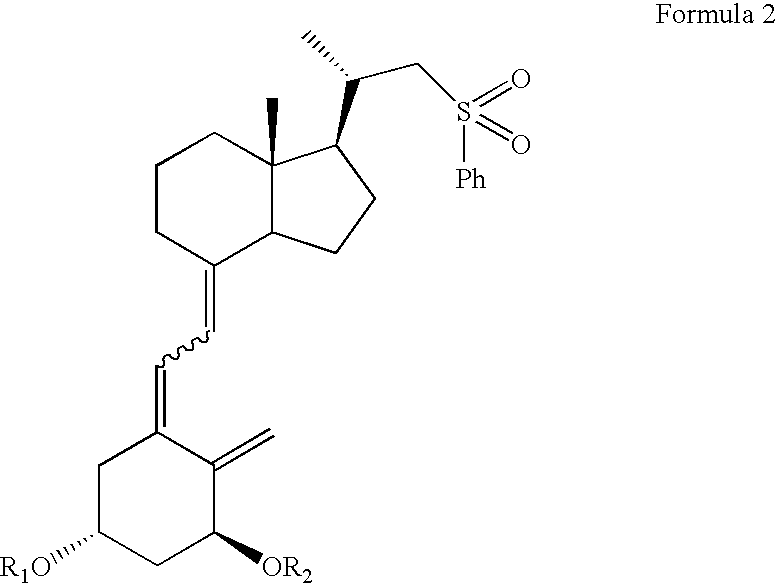Process for the preparation of calcipotriol
- Summary
- Abstract
- Description
- Claims
- Application Information
AI Technical Summary
Benefits of technology
Problems solved by technology
Method used
Image
Examples
example 1
(5Z,7E)-(1S,3R,24S)-1,3-bis(t-butyldimethylsilyloxy)-(22R,23R / 22R,23S / 22S,23R / 22S,23S)-22-sulfonylphenyl-23-hydroxy-24-cyclopropyl-24-t-butyldiphenylsilyloxy-9,10-secochola-5,7,10(19)-trienes (4)
[0039](5Z,7E)-(1S,3R)-1,3-bis(t-butyldimethylsilyloxy)-22-sulfonylphenyl-23,24-dinor-9,10-secochola-5,7,10(19)-triene (Formula 2, R1=R2=TBDMS) (384 mg, 0.55 mmol) was dissolved in THF (2 mL). The flask was placed in a cooling bath (−68° C.) on a magnetic stirrer under Ar. While stirring, n-butyl lithium (1.6 M in THF, 350 μL, 0.56 mmol)) was added drop-wise with a syringe. Stirring was continued for 30 min. at −68° C. Next, (2S)-2,2-cyclopropyl-t-butyldiphenylsilyloxyetanal (Formula 3, R3=TBDPS) (200 mg, 0.59 mmol) was slowly added drop-wise. Cooling bath was removed after 30 min. and the reaction mixture was stirred for additional 2 h. at ambient temp. Brine (1 mL) was added, organic phase was separated and dried over Na2SO4 (100 mg). After filtration, solvents were removed under reduced pr...
example 2
(5Z,7E,22E)-(1S,3R,24S)-1,3-bis(t-butyldimethylsilyloxy)-24-cyclopropyl-24-t-butyldiphenylsilyloxy-9,10-secochola-5,7,10(19),22-tetraen (5)
[0040]The mixture of (5Z,7E)-(1S,3R,24S)-1,3-bis(t-butyldimethylsilyloxy)-(22R,23R / 22R,23S / 22S,23R / 22S,23S)-22-sulfonylphenyl-23-hydroxy-24-cyclopropyl-24-t-butyldiphenylsilyloxy-9,10-secochola-5,7,10(19)-trienes (Formula 4, R1=R2=TBDMS, R3=TBDPS) (500 mg, 0.45 mmol) was dissolved in THF (1 mL), in a round-bottom flask of 10 mL capacity. The flask was placed on a magnetic stirrer and saturated methanolic Na2HPO4 solution (2 mL), followed by sodium amalgam Na / Hg (1.2 g) were added. The reaction mixture was vigorously stirred at ambient temp. for 2 h. The solution was decanted and the solvents were removed under reduced pressure. The product was extracted with hexane (3×5 mL) from dry residue. Hexane was evaporated and the residue was filtered through silica gel (2 g). (5Z,7E,22E)-(1S,3R,24S)-1,3-bis(t-butyldimethyldimethylsilyloxy)-24-cyclopropyl-...
example 3
(5Z,7E,22E)-(1S,3R,24S)-24-cyclopropyl-9,10-secochola-5,7,10(19),22-tetraen-1,3,24-triol (1)
[0041](5Z,7E,22E)-(1S,3R,24S)-1,3-bis(t-butyldimethylsilyloxy)-24-cyclopropyl-24-t-butyldiphenylsilyloxy-9,10-secochola-5,7,10(19),22-tetraene (Formula 5, (R1=R2=TBDMS, R3=TBDPS) (276 mg, 031 mmol) was dissolved in THF (2 mL) under Ar. The solution was warmed in a heating bath (+60° C.) on a magnetic stirrer. Tetrabutylammonium fluoride solution (1 M in THF, 1.0 mL, 1.0 mmol) was added drop-wise and stirring was continued for 1.5 h (+60° C.). After removal of a heating bath, the solution was cooled down to 20° C. and 1 mL of brine was added. Organic phase was separated, dried over Na2SO4(200 mg), filtered and condensed under the vacuum. The crude product was contaminated with 2.2% of (22Z)-isomer of calcipotriol (HPLC). The residue was filtered through silica gel (2 g). After removal of solvents, the resulting solid was crystallized from ethyl acetate (500 μL). (5Z,7E,22E)-(1S,3R,24S)-24-cycl...
PUM
| Property | Measurement | Unit |
|---|---|---|
| Fraction | aaaaa | aaaaa |
| Fraction | aaaaa | aaaaa |
Abstract
Description
Claims
Application Information
 Login to View More
Login to View More - R&D
- Intellectual Property
- Life Sciences
- Materials
- Tech Scout
- Unparalleled Data Quality
- Higher Quality Content
- 60% Fewer Hallucinations
Browse by: Latest US Patents, China's latest patents, Technical Efficacy Thesaurus, Application Domain, Technology Topic, Popular Technical Reports.
© 2025 PatSnap. All rights reserved.Legal|Privacy policy|Modern Slavery Act Transparency Statement|Sitemap|About US| Contact US: help@patsnap.com



